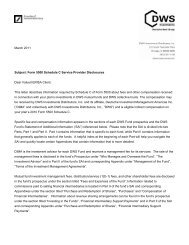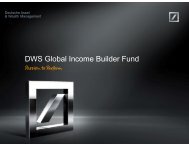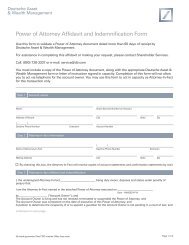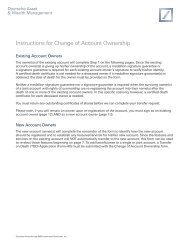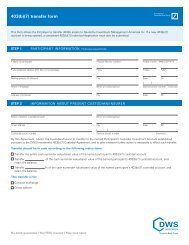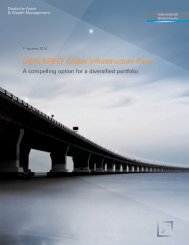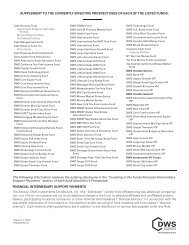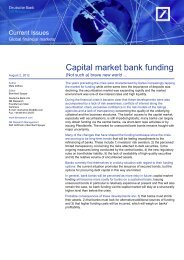Investment Insights Dezember 2011 - DWS Investments
Investment Insights Dezember 2011 - DWS Investments
Investment Insights Dezember 2011 - DWS Investments
You also want an ePaper? Increase the reach of your titles
YUMPU automatically turns print PDFs into web optimized ePapers that Google loves.
<strong>Investment</strong> <strong>Insights</strong>Outlook 2012
Table of contentsIntroduction from the CIO 3Regional perspective 4Our House View: Economic and policy themes for 2012 5Macroeconomic outlook 10Portfolio management in 2012 17Ten <strong>Investment</strong> topics for 2012 20Forecasts and current data summarized 22Asset Allocation 25Key contacts: our Global Strategy Team 26Our Global <strong>Investment</strong> Committee (GIC),Private Wealth ManagementKevin Lecocq (Chair)Global Chief <strong>Investment</strong>OfficerArnaud de Servigny(Deputy)Global Head of DiscretionaryPortfolio Management andStrategyLarry V. AdamChief <strong>Investment</strong> Strategist,USYves CochezSenior Portfolio Manager,Latin AmericaOwen FitzpatrickHead of Global EquityPractice,USBen PaceChief <strong>Investment</strong> Officer,AmericasBjörn JeschHead of DiscretionaryPortfolio Management,GermanyElke Speidel-WalzChief <strong>Investment</strong> Strategist,GermanyStéphane JunodHead of DiscretionaryPortfolio Management,EMEAMartyn SurguyHead of DiscretionaryPortfolio Management,UKAnurag MaheshHead of Global <strong>Investment</strong>and Key Client Solutions,Asia PacificChristian NoltingHead of DiscretionaryPortfolio Management andStrategy,Asia PacificArt builds. Art questions. Art transcends borders. Art works.Deutsche Bank has been opening up the world of contemporary art to the public through its own substantial collection,its exhibitions, and its joint projects with partners. Around the world. For thirty years.More information can be found in the online art magazine at www.db-artmag.com.Drawing a Curtain by Ken Kiff at Deutsche Bank, London© The Estate of the ArtistPhoto: Jacqueline Duschkin
Introduction from the CIOKevin L. LecocqDear reader,The world is now changing fundamentally, after a 30-year period following market deregulation in theearly 1980s.Developed economies’ governments must now face up to unsustainable fiscal positions. Economicgovernance will have to change as result. Social welfare systems developed since World War II areno longer workable, and this is likely to add to political and social stresses.In this environment, any policy consensus is likely to be less assured. This is already being demonstratedby the debate over the desirable role for central banks.There will be major implications for investment management. Under conditions of continued uncertaintyand volatility, it will be necessary to take a dynamic approach to portfolio rebalancing, and to use financialinstruments and other shock absorbers to reduce risk.But remember that – assuming some resolution to the Eurozone crisis – global economic growth isstill likely to be greater than 3 percent, and this will create investment opportunities. Equity in wellgoverned,flexible companies plugged into this global growth is trading at attractive valuations. Moretactical opportunities will exist as a result of policy changes. 2012 could still prove an interesting yearfor investors.Best wishes for 2012.Sincerely,Kevin L. Lecocq,Global Chief <strong>Investment</strong> Officer<strong>Investment</strong> <strong>Insights</strong> December <strong>2011</strong> Page 3
Perspective from the USBen PaceRecent data adds support to our view that the US economywill skirt a recession during 2012, and even suggests thatgrowth is firming somewhat. We are seeing momentum inaggregate demand from both the consumer and businesssectors, and moderate improvements in the labor marketwhich are supportive of positive economic growth. The data,however, does not indicate the above-trend growth thatusually follows severe, financial crisis-induced recessions.Certainly, significant risks to the US economy remain. TheEuropean sovereign debt crisis could create headwinds forthe US economy through financial contagion. There is alsoconsiderable US political uncertainty that could weigh ongrowth as the US faces its own fiscal issues which will befurther complicated as political parties posture for the upcoming2012 elections. The housing overhang and reticence on thepart of banks to lend could also be persistent drags on economicgrowth. While a moderation in emerging market growthremains a concern, it appears the risk of a hard landing byChina has ebbed, as China policymakers are afforded greaterflexibility to move to a less restrictive monetary policy inresponse to lower inflation.On the positive side, economic conditions in the US haveimproved. Housing prices are now more in line withfundamental value and the oversupply of housing haslessened, somewhat, due to a lack of building activity.Households continue to trim debt and credit conditionshave improved, but all of these nascent trends have along way to go. We expect inflation to remain in check, inlarge part due to excess capacity, giving the Fed leewayto step in if needed. Importantly, the excess inventory thattypically leads to recession does not exist and pent-updemand will likely be released when confidence returns.Inventories are not likely to be replenished quickly, butbarring a significant setback, should not be cut further.We remain constructive on US equities and expect the marketto rise over the next three and 12 month periods supportedby strong earnings and historically attractive valuations.Heightened volatility is expected over this time frame, however,as the Eurozone leaders are expected to struggle to reacha comprehensive plan to stem the sovereign debt crisis and theUS continues to be conflicted in its efforts to tame the deficitwhile also promoting growth.Ben Pace,Chief <strong>Investment</strong> Officer, AmericasPage 4 <strong>Investment</strong> <strong>Insights</strong> December <strong>2011</strong>
Untitled A / 7, Untitled A / 15, Untitled A / 8. All by Ken Kiff at Deutsche Bank, London© The Estate of the ArtistPhoto: Jacqueline DuschkinOur House ViewEconomic and policy themes for 2012:facing up to changeArnaud de Servigny
Arnaud de Servigny / Our House ViewInvestors will remember <strong>2011</strong> as the year of sovereign debtcrises, just as other previous years stay linked in the collectivememory with credit crunches, stock market rallies and so on.But, in reality, events do not arrange themselves so neatly tosuit calendar years, and we go into 2012 with many questionsstill unanswered. Most obviously, will the Eurozone survivein its current format? Will the sovereign debt crisis get worsein 2012? Will it mutate into a rather different form? Will thisinevitably further sharply reduce the performance of riskyassets? And in this environment of extreme uncertainty, is theconcept of a “risk free” asset still meaningful? Presumed safehavens as AAA-rated debt, gold, cash, and real estate (in someregions) are now looking increasingly uncertain.Making an accurate prognosis based on tactical judgmentsis impossible in such a quickly evolving context. But there issome value in stepping back, looking at the world we live in,and identifying some key ongoing themes that will make thesituation look different in 2012 and influence asset prices.The four themes below all demand substantial policy progressin 2012, if the situation is not to deteriorate further. So, while<strong>2011</strong> was a year of challenges, 2012 will be a year ofunavoidable and major change – creating risks, but alsoopportunities.1. The year when the bills come dueUnfortunately it is already clear that 2012 will be the yearwhen the bills come due for most developed economies.Paying them will be painful.The “bills” were presented in <strong>2011</strong>, as the size of the problemposed by fiscal and debt imbalances became evident. Thisproblem had been brewing for three years: after the 2008 creditshock, governments compensated for anaemic levels ofeconomic activity by expanding public spending, through taxreliefs to individuals, enhanced support to the unemployedor through ad hoc public capital spending. Increased spendingcombined with subdued levels of tax collection resulted inrapidly increasing public deficits, which in turn translated intohigher debt levels. It was soon evident to some observersthat public debt might quickly reach unsupportable levels.In response, the much disparaged rating agencies downgradedseveral large developed economies. And, since June <strong>2011</strong>,financial markets have become increasingly selective onEuropean sovereign debt, to the point where many of thesemarkets have, at times, almost frozen up. In a vicious spiral,the unfortunate interplay between rising fiscal deficits and skyrocketingspreads, threatens to make debt servicing costsalmost unbearable.There is now a consensus amongst both markets and policymakers that the developed economies cannot keep goingin this fashion. Debt pressures mean that governments arerunning out of ammunition to support their economies viafiscal incentives. Moreover, the citizens and corporations ofthese economies – who have so far largely benefited fromgovernment support – are now affected too, and are beingasked to contribute more through higher overall rates oftaxation.Past performance is not indicative of future returns. No assurance can be giventhat any forecast, investment objectives and/or expected returns will be achieved.Page 6 <strong>Investment</strong> <strong>Insights</strong> December <strong>2011</strong>
Scaling back current fiscal incentives is likely to have a bignegative impact on growth. In the US, it could take close to 2percentage points off GDP growth in 2012 – which, despitethis, is likely to exceed 2 percent – and possibly more in 2013(Figure 1). In Europe, with almost all countries implementingmore balanced and, one hopes, more sustainable fiscal policies,the region seems certain to be in recession in the first halfof 2012.How much changing fiscal policy will subtract from US growthin percentage pointsUnder current law Under current policy0.0-0.5-1.0-1.5-2.0-2.5-3.02. Global economic governance in transitionThe second salient trend we have observed is a very strongcontrast between the effectiveness of public and privategovernance, with attention focused on some of the shortfallsof public governance. In response, global economicgovernance is in transition.Companies are not economies! Most corporates – especiallylarger ones – have steered their way through the currentcrisis effectively, adjusting their activities to suit the ebbingstrengths of the domestic economies they operate in. Theyhave been aided, of course, by high levels of unemploymentexerting downwards pressure on wages. In contrast,public bodies in the US and in Europe have appeared to beperforming quite poorly. In the US, the embarrassingoutcome of the negotiations on the “debt ceiling” in mid-<strong>2011</strong>damaged perceptions of the effectiveness of US policymakers; the failed negotiations of the “Super Committee”later in the year added to the scepticism. In Europe, enormousconfusion surrounds the decision making process at botha national and supranational European level, leaving thedamaging impression that policy makers are simply not up tothe task, and incentivising several countries to trust their fateto unelected “technocratic” administrations. It is hard to thinkthat this state of affairs can be sustained throughout 2012.At present, it appears that the needed reform will requireeither a higher degree of political and fiscal integration aroundthe Euro or a partial dismemberment of the Eurozone.-3.5<strong>2011</strong> 2012 2013Figure 1 Source: Deutsche Bank, Global Markets. As of November 29, <strong>2011</strong>Past performance is not indicative of future returns. No assurance can be giventhat any forecast, investment objectives and/or expected returns will be achieved.<strong>Investment</strong> <strong>Insights</strong> December <strong>2011</strong> Page 7
Arnaud de Servigny / Our House View – continuedIn 2012, we need to get to the point where everybodyunderstands what the Eurozone stands for, with each memberstate having to make a choice to stay in it or not. Remaininga member will require a formal commitment to fiscalconvergence. Germany and France will have a historic roleto play here, both in ensuring that the convergence process istotally transparent and also in supplying the determinationto carry the process through to its conclusion. In this delicatesituation, financial institutions who were at the center of the2008 crisis will continue to find themselves at risk. They carry,in a sense, the collateral damage from previous Europeanfinancial opacity, in the form of their detrimentally large holdingsof Eurozone sovereign debt. The risk is that, because theyhave to deleverage their balance sheet to cope with potentiallosses on this debt, they cannot therefore properly fulfil theirrole of funding a Eurozone economy through domestic lending.This critical situation means that a clarification of proposedgovernance changes in Europe is needed very quickly, if weare to bolster confidence in the financial institutions and avoidsome defaults (Figure 2).Exposure of European banking systems to peripheral countriesin EUR bn250200150100Greece Italy Portugal Spain Ireland Belgium500SpainItalyFranceGermanyBelgiumGreeceUKNetherlandsFigure 2 Source: Deutsche Bank, Global Markets. As of November 29, <strong>2011</strong>Other3. Rewriting the “social contract”Why is it proving so difficult to find solutions quickly, especiallygiven the shared sense of urgency, and the obviously awfulimplications of failing to do so? Our thesis is that thegovernments in developed economies are facing the challengeof rewriting their “social contract”. Economies rely primarilyon the dynamism of capital markets and labor forces to drivethe engine of economic growth. But, as a residual, thereis, in effect, an implicit agreement between governments,populations and corporations whereby taxation andgovernment spending are used in part to make provision forthose who cannot work, for reasons of age, infirmity oradverse labor market conditions.As has long been understood, the process of economicglobalization results in a heightened level of competition,with consumers benefiting greatly from abating marketprices for goods and increasingly services set on a globalbasis. But this process of competition also translates intoincreased pressures on the financing of social systems,as the cost of them threatens both to make corporationsuncompetitive and to weaken the productive economyoverall. As we have noted above, governments’ financialresources are already stretched; increased taxation oncorporations, likely to be already struggling with theconsequences of bank deleveraging in 2012, risks makingthem uncompetitive – meaning that such a policy wouldlikely be counterproductive.The conclusion is that, as with government finance moregenerally, the current situation cannot continue for muchlonger, and that some major decisions will have to be takenin 2012. One central problem is that in most developedeconomies, the existing expectations of citizens regardingthe state provisions – whether explicitly labelled the “welfarestate”, as in Europe, or regarding Medicare, Medicaid andthe individual elements of state provision in the US – wereestablished several decades ago, in a very different economicenvironment. Not only was global competition much lessintense, demographics were also skewed towards the youngrather than the old, and healthcare provision did not entailsuch high costs. It is no longer possible to pretend thatimprovements in operating efficiency and spending controlcan, on their own, provide a remedy to the problemssurrounding social provision. It is particularly difficult tocurtail this social public spending to current realities at aPage 8 <strong>Investment</strong> <strong>Insights</strong> December <strong>2011</strong>
time when the divide between the rich and the poor is verylarge, having been increasing for at least a decade. Hence,we now need to rewrite the “social contract” between thestate and its citizens, something that will have majorimplications for corporates, too. The debate on the “socialcontract” is moving onto a deep and potentially disruptivelevel. In essence, what does fairness mean? In the US, manyof the existing political divisions are prompted by preciselythis issue. Ideological divides in Europe may not appear soacute, but any redefinition of the European “welfare state” willrequire an answer to this question – and some major changesto the status quo.It is worth stressing that a resolution to the debate around thesocial contract would be equally to the wealthy’s advantage,as to the recipients of government spending. One of the mostinteresting observations from <strong>2011</strong> is that financial assetsdo not tend to do well when there is uncertainty around the“social contract” and its sustainability – this is at the root ofthe European crises. It is therefore in the interest of all citizens,at all wealth levels, to find a compromise, for both economicand social reasons. We need a lot of clarification on this issuein 2012, but must accept that the complexity of the underlyingissues here will work against immediate progress.A more highly integrated environment is not a simpler one,however. In fact, its functioning appears more complex. Oldeconomic rules may now look either less universal or lesseffective, as policy makers, central bankers and regulators areforced to sail into uncharted seas. The policy consensus isas a result less solid. One illustration of this is the disputedrole of central banks as “market makers of last resort”, inorder to stop a drying up of liquidity. The Fed has been doingthis most willingly, to protect the mortgage market in theUS, while the European Central Bank (ECB) is proceeding muchmore cautiously regarding the sovereign debt market inthe Eurozone. The reality is that we cannot fully assess all thelong-run positive / negative consequences of these policyactions for the economies concerned and must accept the factthat we will have to operate under conditions of considerableuncertainty in the foreseeable future. In the following pages wetherefore highlight some of the immediate economic problemsthat we face in the key regions of the US, Eurozone and Asiabefore returning to their investment implications.4. The world is also getting smaller, but more complexPrecisely because of globalisation, the world is also gettingsmaller, but more complex to navigate.This has already had a major impact on investment decisionmaking. Until recently, the received wisdom had been thatportfolio diversification across regions would help mitigatelosses. But the events of <strong>2011</strong>, and of 2008 – 2009, have shownus that, during a period of economic tension, investors cannotrely on regional asset valuation independence to provide safehavens. Markets in Asia, Europe and the US are largelyintertwined, so asset prices have been moving together with ahigh degree of correlation. This probably corresponds to astructural trend, and one that will continue to be particularlyobservable during highly stressed market conditions. Put thisway around, this observation might be taken as unfavorableto globalization, but this view would be over-simplistic ascloser integration obviously has its positive side too, with, forexample, the Chinese government’s efforts in 2009 to supportgrowth through very aggressive state-driven investmentprograms having had substantial positive side-effects globally.Past performance is not indicative of future returns. No assurance can be giventhat any forecast, investment objectives and/or expected returns will be achieved.<strong>Investment</strong> <strong>Insights</strong> December <strong>2011</strong> Page 9
The Estate by Sigmar Polke at Deutsche Bank, London© VG Bild-Kunst, Bonn <strong>2011</strong>.Photo: Jacqueline DuschkinMacroeconomic outlookLarry V. Adam, Christian Nolting, Elke Speidel-Walz
The US in 2012: it’s all about confidenceLarry V. AdamEconomic growth of 2– 2.5 percent expectedin 2012, but substantial domestic and externalrisksFederal Reserve can implement further nontraditionalpolicy stimulus if necessaryOur base case scenario is that the US grows at 2– 2.5 percent(Figure 1) in 2012, having picked up pace in Q3 <strong>2011</strong>, butsubstantial domestic and external risks remain. Uncertaintymeans that our market forecasts must be muted, if positive,too. 2013 could, in fact, prove to be worse than 2012, as theeconomy is simultaneously hit by the “automatic”Congressional budget cuts, the expiration of the Bush taxcuts, the likely end of the 2 percent payroll tax cuts and theintroduction of taxes tied to healthcare reform.ChallengesWhile a recession is likely avoidable in 2012 – thanks to strongbusiness spending, robust exports to the emerging markets,positive job growth and some politically-driven initiatives inan election year – the US economy will not be without itschallenges. The most immediate domestic risk is a tampingdown of consumer and business confidence by economic,political and international uncertainty. Depressed consumerconfidence could lead to reduced consumer spending andheightened risk aversion while weak business confidence couldlimit job creation: together, they could lead to a self-fulfillingrecession.Forecast US growth in 2012 – quarter-on-quarter, annualizedin percent, quarter-on-quarter, annualized3.53.02.5Retail sales have been resilient so far, despite poor consumerconfidence, but this situation cannot continue indefinitely. Weakwage growth would be one factor holding back a recoveryof consumer confidence, and we are concerned that the labormarket will remain tepid in 2012, with the unemployment rateremaining above 8.5 percent.Another – linked – risk to sustainable US economic growthis the still poor state of the US housing market. A weakhousing market stifles economic growth as job seekers arenot able to move to take new jobs (because their existinghome is difficult to sell, or because negative equity meansthat selling it would crystallize a loss that they cannot fund).Moreover, declining house prices can trigger a negative netwealth effect, reducing consumer spending; further declinesin home prices would of course also put the banking sectorat risk of further write downs. It is becoming increasinglyevident that some sort of government intervention in thehousing market may be necessary, something that mightappeal to the current administration in an election year –although its ability to implement stimulus measures wouldbe limited by the US’s debt and deficit situation.Policy responseIf the US economy were to show substantial signs of stress,we believe that the Federal Reserve would be inclined to engagein further quantitative easing. Fed Chairman Bernankecontinues to make it clear that he will use all policy measuresto avoid a recession. With headline inflation pressures likelyto subside, helped by recent falls for many commodity prices,the Fed should have ample room to implement further nontraditionalmonetary policy initiatives, and they may be in theform of mortgage-backed security purchases in order tooffer more aid to the housing market. Declining inflationarypressures will also allow the European Central Bank andemerging market central banks to cut interest rates as wellto stimulate their economies.2.01.51.00.50Q3 <strong>2011</strong>* Q4 <strong>2011</strong> Q1 2012 Q2 2012 Q3 2012 Q4 2012*ActualFigure 1 Source: Deutsche Bank, Global Markets. As of November 29, <strong>2011</strong>Past performance is not indicative of future returns. No assurance can be giventhat any forecast, investment objectives and/or expected returns will be achieved.<strong>Investment</strong> <strong>Insights</strong> December <strong>2011</strong> Page 11
Larry V. Adam / The US in 2012 – continuedThe improvement in US economic data in the second half of<strong>2011</strong> has been in contrast to the increasingly poor outlookfor the Eurozone outlook. But the US economy cannot decouplefrom trouble in other economic regions. A European creditcontagion or a Chinese hard landing would have negativerepercussions for an already vulnerable US economy. Investorscannot ignore the outcomes to these potential risks.Asset classesGiven this uncertainty, our financial market outlook must bemuted as well. Continued volatility will dampen investorsentiment, especially with ongoing risks in the run-up to theelection. Political positioning seen during the debt ceilingdebate and the failed “Super Committee” deliberations suggestpartisanship will remain in the fore. While heightened riskaversion and uncertainty are likely to keep Treasury rates “lowerfor longer”, our economic growth forecasts are supportive ofa modest rise in Treasury yields from current levels, which aremore consistent with recessionary conditions. As a result, weremain cautious on US Treasuries and encourage investors todiversify into higher yielding, lower duration sectors such ashigh yield and emerging market debt.S&P 500 Earnings per share reach record highs in Q3 <strong>2011</strong>in USD, rolling four quarter sum1009080706050403020100S&P 500 EPS Rolling Four Quarter Sum1940–19501950–19601960–19701970–19801980–19901990–2000Figure 2 Sources: FactSet; FirstCall. As of November 29, <strong>2011</strong>2000–2010US equities, while volatile, are likely to be one of the betterperforming asset classes in 2012. US corporations remain abright spot for the US economy, recording record earningsin Q 3 <strong>2011</strong> (Figure 2). Based on fundamentals, the S&P 500should trade upwards to 1.375 by the end of 2012. Whilecorrelations are likely to remain high, we believe selectivelywill remain critical as investors become more discerningand assess the visibility and sustainability of earnings forinternational regions, sectors, and individual securities. Withearnings growth set to decelerate, strong operating leverageis likely to be replaced by financial leverage. With the Fedkeeping interest rates low through mid-2013, corporationsare likely to issue debt and/or use the record amount ofcash on balance sheets for stock repurchases to bolsterearnings. Similarly, low interest rates make dividends moreattractive and we expect corporations to continue to increasetheir dividend payments to attract investors.Past performance is not indicative of future returns. No assurance can be giventhat any forecast, investment objectives and/or expected returns will be achieved.Page 12 <strong>Investment</strong> <strong>Insights</strong> December <strong>2011</strong>
Asia in 2012: resilience in adversityChristian NoltingGrowth slowdown is likely to be braked byintra-Asian trade and domestic consumptionFalling inflation should give policymakersroom for maneuverAsian economic growth is expected to continue to slow (albeitgradually) in 2012, because of the impact of slower growth inthe developed economies. Intra-Asian trade and further growthin domestic consumption is likely to cushion the blow, however.Sustainable wage growth, low unemployment and low debtto-GDPratios will be supportive of our positive stance on Asia.ChallengesOne of the key challenges that Asian economies must face willbe the impact on Asian exports of lower growth in the developedeconomies. The more open and trade-reliant Asian economiessuch as Singapore, Hong Kong, Taiwan and South Korea arelikely to suffer most from slower EU and US growth, and thusslower growth in exports to the developed markets. But, setagainst this, stronger demand from the developing world hasbecome increasingly important in driving Asia’s exports inrecent years.In addition, domestic consumption in Asian economies has,so far, proved resilient to slower exports and has becomean increasingly important source of GDP growth for Asianeconomies. Over the coming years, it will be interestingto see whether Asian policy makers can steer their economiestoward being rather more consumption-oriented.Asian economies’ foreign portfolio holdings as a percentageof FX reservesin percent140120100806040200November 2008 October <strong>2011</strong>But just how much can Asian consumption growth offsetthe impact of slower developed markets growth? Lookingfirst at past consumption trends if, for example, we lookat correlation data for the last six years, then it would appearthat Chinese retail sales (taken as a proxy for domesticconsumption) are much more correlated with householddisposable income levels than with US and Eurozonegrowth. A broader look at pan-Asian consumption trendsalso reminds us that Asian consumption continued togrow in 2009 despite the collapse in US demand in that year.The last time Asian consumption contracted was afterthe Asian crisis of 1997– 1998.A second, and very immediate, challenge could be posed bypossible foreign investor money outflows if global risk aversionrises. Previous global equity sell-offs have been accompaniedby strong outflows from Asia, for example during the 2008/2009 world financial crisis and in mid-<strong>2011</strong>.There are various ways of measuring this. Figure 1 below looksat the size of foreign portfolio debt relative to FX reserves;comparing October <strong>2011</strong> with November 2008 (at the heightof the credit crunch). It suggests that Indonesia, South Koreaand India could now suffer more from a sudden withdrawalof foreign portfolio holdings than in 2008. Alternatively, onecan compare the size of Asian economies’ short-term debtrelative to GDP in October <strong>2011</strong> and November 2008. This israther more reassuring, as the size of short-term debt relativeto GDP has increased only in India, and there not substantially.Yet another approach is to look at the size of the Asianeconomies’ financing gap (their foreign exchange requirementsto fund debt service and imports, minus the revenue fromexports). On this measure, Asian economies have become morevulnerable to outflows, if not by an alarming amount. Indiahas seen the largest increase in vulnerability on this measure,thanks to a large increase in foreign investment inflowscombined with weak foreign reserves accumulation. Korea andTaiwan would appear to have become less vulnerable. Overall,China, the Philippines and Thailand would appear to be theleast vulnerable economies, on this financing gap measure.ChinaVietnamThailandPhilippinesTaiwanIndiaMalaysiaKoreaIndonesiaFigure 1 Source: Deutsche Bank, Global Markets. As of November 29, <strong>2011</strong><strong>Investment</strong> <strong>Insights</strong> December <strong>2011</strong> Page 13
Christian Nolting / Asia in 2012 – continuedPolicy responseHowever, we should not forget that markets have already beenpricing in slower growth in 2012. This has prompted manyinvestors to anticipate some form of policy easing or stimuluspackages from many Asian policy makers in response. Indeed,with trade slowing and a broader slowdown now becomingevident in Asia, Asian central banks are already beginning toact. For instance in China, we have started to see some modestsigns of credit easing with the monthly level of new lendingeasing upwards. In the near term, we could see more crediteasing policies coming from the Chinese policy makers albeitstill at a gradual and modest pace. They could, for example,stop the issuance of People’s Bank of China (PBoC, the centralbank) bills or cut further the banks’ reserve requirement ratio(RRR). Recent announcements by the Reserve Bank of India(RBI) have also indicated a willingness on the part of Indianpolicymakers to ease their grip on liquidity for the first time inseveral months.If inflation in many Asian economies has peaked and continuesto trend lower over coming months, this would provide somescope for Asian policymakers to further ease policy. Our viewon inflation is supported by falling food prices, given that foodaccounts for about one-third of the CPI baskets for countriessuch as China and India. In addition, industrial metal priceshave also declined as a result of fears over global growth in2012.Besides monetary policy easing, Asian central banks couldalso probably consider implementing some stimulus packagesto support growth, if necessary. Most Asian economies stillappear to have fairly strong fiscal positions, characterized bylow and stable deficits and debt (Figure 2), thus providingthem with much more potential “firepower” than governmentsin the developed world to combat slower growth next year.Asset classesAsian equities’ prices will also likely remain sensitive todeveloped markets, as historically they have had a high betarelative to the developed world. Having said that, valuationsare starting to look attractive to us and we are seeingpotential opportunities for investors with a medium to longterm perspective. Compared to their historical average,Central government debt at end 2010, as a percentage of GDP:Asian and other economies comparedin percent10080604020Asian0ChinaOther economiesIndiaIndonesiaMalaysiaPhilippinesSouthKoreaAsian equities look moderately undervalued based on botha price-to-book (P / B) and price-to-earnings (P / E) basis. Ourexpectation is that margins should hold up relatively well, helpedby decreases in the many of the prices of raw materials.In the absence of any policy actions, high dividend yieldingsectors in Asia such as REITs, telecoms and utilities couldremain attractive. Besides their stable yields, these sectorsare relatively less exposed to a slowdown in the developedeconomies and more dependent on local consumption.On fixed income, Asian sovereign re-rating could be a positiveissue running through the year, given that the ratios of Asiancountries’ public debt-to-GDP remain low relative to developedeconomies.ThailandG20AdvancedFigure 2 Source: Deutsche Bank, Global <strong>Investment</strong> Solutions.As of November 29, <strong>2011</strong>EUUKUSPast performance is not indicative of future returns. No assurance can be giventhat any forecast, investment objectives and/or expected returns will be achieved.Page 14 <strong>Investment</strong> <strong>Insights</strong> December <strong>2011</strong>
The Eurozone in 2012: no quick fixElke Speidel-WalzOur base case forecast is for a controllableEurozone recession in 2012But the risk remains of a very sharpcontraction and Eurozone disintegrationAt best, the Eurozone will experience a controllable recessionin 2012, with all economies contracting apart from Germany’s(Figure 1). Uncertainties will weigh on government bondmarkets, in the first half of the year at least. The second half ofthe year could be rather better. The alternative is a full-blowndownturn, with several economies exiting the Eurozone.ChallengesThe fundamental problem for the Eurozone is how to maintaina currency system where monetary policy is centralized, butwhere members have very different approaches to fiscal policy.The latest policy initiatives attempt to to tackle this. Previousattempts to regain financial markets’ confidence by puttingtogether impressive-sounding rescue programs, while grantinghelp only in exchange for progress on fiscal austerity, have notmanaged to contain the crisis. And with one member, Greece,having a still unsustainable debt load, there is a possibilityof further debt defaults (above the already agreed 50 percent“haircut”) and possibly a Greek exit from the Eurozone nextyear.A combination of fiscal austerity, rising financing costs andheightened uncertainty over the future of the Euro, is pushingthe region into a recession. Recession, through lowering thetax take and boosting spending (through “automatic stabilizers”such as unemployment benefit) makes fiscal consolidation,already a major problem (Figure 2) even more difficult. One“rule of thumb” reckons that fiscal tightening equivalent to 1percentage point of GDP pulls down GDP growth by 0.7percentage points. On the other hand, a 1 percentage pointreduction in GDP growth leads to a cyclical widening of thefiscal deficit equivalent to 0.4 percentage points of GDP. Thismakes the necessary fiscal adjustment in some countriesextremely ambitious. Some countries have, so far, managedbetter in this environment than others, but none lookcompletely secure.Limited cash, together with political and legal hurdles, meanthat further single-country rescue programs look unlikely. TheEuropean Financial Stability Facility (EFSF) and its plannedsuccessor, the European Stability Mechanism (ESM) cannotdeal with a problem of the size of the Italian bond market(Euro 2 trillion, the world’s third largest). One initial idea wasto leverage the available capital via an insurance program,but this seems unlikely to work due to the insufficient meansof the EFSF, the result both of its limited financial firepowerand also the expectation that the number of Eurozone countriesable to finance a rescue package will fall.Eurozone 2012 GDP growth/contraction, by countryin percentEurozone: Fiscal indicators reveal seriousness of the problemas percentage of GDPFiscal balancePublic sector debt0.50-0.5-1-1.5-2-2.5-3-3.5GermanyFranceItalySpainNetherlandsBelgiumAustriaFinlandGreecePortugalIrelandEurozoneGermany -1.4 81.1France -5.4 86.8Italy -2.5 119.8Spain -6.0 71.0Netherlands -3.5 64.0Belgium -5.0 97.5Austria -3.2 75.4Finland -1.5 52.2Greece -6.6 166.0Portugal -6.4 107.4Ireland -9.1 117.9Eurozone -3.6 88.7Figure 1 Source: Deutsche Bank, Global Markets. As of November 29, <strong>2011</strong>Figure 2 Sources: Deutsche Bank, Global Markets; EU Commission.As of November 29, <strong>2011</strong><strong>Investment</strong> <strong>Insights</strong> December <strong>2011</strong> Page 15
Elke Speidel-Walz / The Eurozone in 2012 – continuedBoth the German Bundesbank and the President of the ECB,Mario Draghi, do not want the ECB to assume the role of alender of last resort for governments, and it is supported in thiswish by the German government. Even if a majority of theECB’s Council were to try and overrule the German position,this might not be well received by the financial markets asit could be seen as endangering Germany’s commitment tothe Eurozone. Jointly-issued Eurobonds would also be nomiracle solution: the pre-condition – fiscal union – needstime, and the risk that large-scale issuance of Eurobonds couldtrigger a rise in German bund yields has clearly risen.Policy responseOverall, we expect a disruptive first half of 2012 for the Eurozonebut more clarity in the second half of the year. In our basescenario, Eurozone output as a whole contracts by 0.5 percentin 2012, pulled down by fiscal tightening, higher financingcosts in most countries, and uncertainty damaging sentiment.But continued global growth, falling Eurozone inflation (below2 percent) and ECB rate cuts will, we hope, limit the downside.In our base case scenario, the expectation is that the drive forfiscal and structural reform would gather pace in the largercountries, with Italy starting structural reforms and restoringmarket confidence (helped by ECB purchases in the firstquarter of 2012, due to the country’s large financing need).Reforms in France could step up a gear after the May 2012elections. Spain, Ireland and Portugal are likely to make furtherprogress on their fiscal and reform agendas. They could getfurther help and / or limited debt relief to ease fiscal and socialproblems. But in Greece there is a high risk of a disorderlydefault, with losses much greater than the planned 50 percent.than raise capital. Another risk stems from the very challengingpolicy outlook. Fiscal austerity-fatigue and rescue-fatigue,already on the rise, could become more serious. And if thenumber of AAA-rated sovereigns gets reduced, Germanycould lose credibility due to stretched guarantees, and marketsmight then lose confidence in any bail-out program. WereItaly to embark too late on reform plans, or were France not tostep up its reform drive after its May elections, there couldbe a much worse outcome. In this scenario, the Euro systemcould break down in its current form and leave only a fewcountries with a common currency.Asset classesEven under our base case scenario, government bonds wouldstill have substantial risk. (Consider, for example, what wouldhappen in the new Greek government did not stick to reformsafter its election in February or were Italy’s very high financingneeds in Q 1 to cause problems.) In the course of 2012, reformsin Spain and Ireland could start to have more obvious resultsand the high spreads available on these countries’ bonds mighteventually become attractive.Our overall view is that equities are likely to be the mostattractive asset class in the Eurozone in 2012. But this assumesthat global growth remains robust, supported by emergingmarkets and moderate but decent growth in the US; also, wecontinue to dislike Eurozone financials. Equities valuationsare attractive, and corporate fundamentals and balance sheetsappear sound.It is easy to envisage a much worse scenario, however, witha deeper recession in the Eurozone. This could be either theresult of weaker global growth and/or a more serious creditcrunch in the Eurozone as banks opt to sell assets ratherPage 16 <strong>Investment</strong> <strong>Insights</strong> December <strong>2011</strong>
Untitled by Richard Smith at Deutsche Bank, London© Richard Smith, Flowers Galleries London.Photo: Jacqueline DuschkinPortfolio management in 2012Arnaud de ServignyCoping with risk, capturingopportunities.
Arnaud de Servigny / Portfolio management in 2012In the context of all this transition – of global governance, ofsocial provision systems, and of policy responses – we think itis possible to make two, very broad observations on portfoliomanagement.1. We should expect sustained volatility in 2012, which willrequire a careful, structured but active investment approachOne positive is that, as argued above, we know that thingswill have to change — there can be no more “kicking the candown the road”. These necessary changes are likely to createsustained volatility on the markets, which we can prepare for.The traditional reaction in a situation of high volatility is almostalways to “fly to quality and then do nothing”, that is to avoidrisky assets and to go instead for cash, sovereign bonds, realestate and precious metals. But what is clear to us is that thistime is different and that, because of the nature of this crisis,none of these options can guarantee wealth preservation.Looking at these investment areas in turn:— Cash highlights some potential dilemmas. In a situation ofhigh sovereign debt tension, one traditional tool used bygovernments has been currency debasement. Moreover,this process is not always voluntary, as the strength of acurrency is linked with the stability of its government. So,with this crisis deeply related to governments’ effectivenessand thus stability, some real caution is needed here: cashis by no means as “safe” as it might appear.— Among sovereign debt, the current safe haven wouldappear to be US Treasuries but fundamentals-drivenmodels suggest a fair value for US rates of around 3.20percent rather than their current levels of close to 2percent (Figure 1). So, again, “safe” could prove veryrisky, if Treasuries start being driven more by realitythan by an emotional response.— Real Estate valuation depends largely on the availabilityof mortgages. But in the current environment where banksare being forced to deleverage massively, credit will bescarcer and thus more expensive. The US is still dealing withthe aftermath of a burst housing bubble and it is highlyunlikely that, in the future, limited capital resources elsewherewill be deliberately funnelled into unproductive real estate,particularly in a context of subdued growth.— Lastly, while precious metals make sense in an inflationarycontext, they should appeal less in the present environmentwhere inflation risk is receding quickly, at least in Asia andin Europe. Of course, individual policy events may push upthe gold price, probably temporarily, but a sustained andsubstantial rise in precious metals prices is unlikely to be onthe agenda in 2012.So investors find themselves in a situation where “safe” assetscannot guarantee wealth preservation, and therefore mustcontemplate how best to invest in risky assets. Doing thiswell requires several things. The first requirement is to buildactive risk management into the portfolio, using eitherfinancial instruments that reduce downside risks, or assetsthat constitute shock absorbers. The second requirement isto manage a portfolio dynamically through a robust investmentprocess that captures which investment “regime” we arein, while avoiding the expensive pitfalls of spurious markettiming.Actual vs. model-predicted levels for US 10-year Treasury yieldsin percentActual Model-predicted forecast76543212000 2002 2004 2006 2008 2010Figure 1 Source: Deutsche Bank, Global Markets. As of November 28, <strong>2011</strong>Past performance is not indicative of future returns. No assurance can be giventhat any forecast, investment objectives and/or expected returns will be achieved.Page 18 <strong>Investment</strong> <strong>Insights</strong> December <strong>2011</strong>
2. There are ways to leverage this global growth throughsmart asset selectionMore fundamentally, it is important to realise that risky assetscan offer opportunities in 2012. Global growth in 2012 shouldstill be close to 3 percent, which is substantial. So our secondportfolio management theme is that we strongly believe thatthere are ways to leverage this global growth through smartasset selection.For very opportunistic investors, focused on trading, 2012could represent a year of many opportunities, with periodsof market dislocation (and thus rapid price change) comingas a consequence of a likely raft of policy announcements,together with central banks and regulator intervention.Remember, too, that banks may well be in such a weak positionthat they cannot provide their usual market-making smoothingfunction, potentially increasing the scope for tactical gains.But there should be longer-term, more fundamentals-driven,opportunities. Large firms, well organized from a governanceperspective, and fully plugged into global growth, should bein a position to take advantage of the situation, with sustainedor growing earnings. In addition, valuations currently appearvery low with price / earnings (P/E) ratios that are typically around12 in the US and below 10 in Europe (Figure 2). This situationshould not last forever. Market sentiment is very negative at themoment, but periods of negative sentiment have in the pastoften been very good entry points into risky assets. One couldadd that, from a behavioural finance perspective, the perfecttiming for entering into such investments is when one iscomfortable with them from a rational perspective, but mustfirst overcome an emotional reluctance to invest. During 2012,we could encounter such a “tipping” point but it will alwaysbe difficult to time the entry point precisely. Of course, thejourney to this tipping moment may well prove bumpy, and thecomplexities outlined above could lead to some accidentsalong the way. A gradual stepping up of exposure to riskyassets could be one solution. Overall, it will be important toremember that financial markets do not wait for solutions tobe implemented before they adjust. Instead, they are primarilylooking for credible solutions to be outlined, accompaniedwith a degree of certainty on their execution – then they move.At some point, we will also need to revisit the geography“dimension”. At the moment, as we have observed above,market correlation means that geography does not makea vast difference, although US equities have beenoutperforming other regions recently. Conversely, Asianequities have not done well, despite the secular upwardtrend of the Asian economies – a useful reminder that marketsdo not always follow macroeconomic developments. Webelieve that all regions will benefit in the first instance fromclarification on our four economic and policy themes thatwill drive developments in Europe and in the US. Once wehave passed this tipping point, then fundamentals will startto matter more.Current price / earnings ratios (LTM*) inthe US and EuropeS&P 500 MSCI Europe14121086420* Last twelve monthsFigure 2 Source: Bloomberg Finance L. P.As of December 2, <strong>2011</strong>Past performance is not indicative of future returns. No assurance can be giventhat any forecast, investment objectives and/or expected returns will be achieved.<strong>Investment</strong> <strong>Insights</strong> December <strong>2011</strong> Page 19
10 <strong>Investment</strong> topics for 2012Arnaud de Servigny, Christian Nolting, Larry V. Adam, Elke Speidel-Walz, Paul WhartonWe now suggest 10 investment topicsthat we think will run through portfoliomanagement decisions in 2012.Investor focus1. Safe may not be safe.Don’t react to future periods of uncertainty by taking refugein traditional safe havens such as cash, sovereign bonds,real estate or precious metals without realizing that the currentrisk environment means that they may prove less safe thanthey appear, and be vulnerable to the effects of frequentpolicy change – the likely backdrop to 2012.2. Walk before you run.After a bruising <strong>2011</strong>, and in a context of continuing uncertainty,investors will be understandably wary of investing in riskyassets. One strategy to overcome reluctance may be to buildup holdings gradually, first focusing on “equity lite” typeholdings (e.g. high dividend-paying stocks, convertibles andhigh grade corporate debt) which are supported byfundamentals.4. Be nimble, but with a safety net.Risk management will remain key throughout 2012, boththrough use of options and through shock absorbing assets(including through equities sector rotation). Consider resortingto regular, dynamic portfolio rebalancing to adjust to economicand market developments.5. Reason should dominate emotion.Investor responses to longer-term changes – as well as shorttermmarket dislocations – will be driven by fear followed,at some stage, by relief. Avoid an emotion-driven responsethat is likely to result in wrong investment decisions, andwrong timing, and make sure that reason always dominatesthe decision-making process.3. Ready, steady…go?Fixing Eurozone and other problems will take time in 2012. Butwhen we get some clarity on progress, not only equities butalso bond markets will start to have a different momentum andregional dynamics will reassert themselves. Timing will be keyfor investments in both Asia and, more selectively, in Europe.Past performance is not indicative of future returns. No assurance can be giventhat any forecast, investment objectives and /or expected returns will be achieved.Page 20 <strong>Investment</strong> <strong>Insights</strong> December <strong>2011</strong>
<strong>Investment</strong> focus6. Big will grow bigger.Large multinational corporations, especially in the US butelsewhere too, should be able to take better advantage of stillstrong global growth, and able to control costs throughstrong governance, which they have exhibited since the 2008crisis. Sectoral and other preferences will change as theyear progresses, with an initial preference for defensive, highdividend-paying stocks. In the US, we like technology,energy and healthcare stocks; in Europe ex-UK and UK, wefavor oil and industrials.7. Capital over labor.Medium-sized companies will find it more difficult to copewith a lower growth environment, as bank lending becomesmore restricted, with their management looking moredefensive. But significant opportunities may exist to restructure,consolidate and revive companies, particularly throughprivate equity investments, potentially boosting productivityagainst the background of a difficult labor market.8. Asian growth generates performance at last.Despite continued strong Asian growth in <strong>2011</strong>, Asian equitiesperformed poorly, with fund flows a major performancecontributor. However, with rising clarity on the developedeconomies’ recovery, the scene may be set for a recoveryin Asian equities and some possible decoupling later in 2012.Look for local longer-term trends too, for example anincreasing emphasis on domestic consumption. And withfalling rates of inflation giving Asian policy makers a degreeof leeway for monetary policy easing, Asian bonds shouldoffer an attractive risk / return balance.9. Phoenix companies in Europe.Later in 2012, the European market is likely to offer somestrong opportunities for longer-term investors. Strong,undervalued, truly global companies may merit consideration,particularly in the larger peripheral economies of Italy andSpain.10. Volatility can be your short-term friend.While the topics above reflect a fundamentals-driven approach,remain aware that volatility and market dislocation in thewake of expected policy actions are likely to cause substantial,very specific, short-term trading opportunities.Past performance is not indicative of future returns. No assurance can be giventhat any forecast, investment objectives and /or expected returns will be achieved.<strong>Investment</strong> <strong>Insights</strong> December <strong>2011</strong> Page 21
Forecasts and current data summarizedUntitled – Motif by Karl Horst Hödicke at Deutsche Bank, London© VG Bild-Kunst, Bonn <strong>2011</strong>Photo: Jacqueline Duschkin
EconomicsGDP growthin percentInflationin percentKey interest ratesofficial, in percent2010 <strong>2011</strong> 20122010 <strong>2011</strong> 2012Current* 3month12monthUSA 3.0 1.8 2.3Eurozone 1.8 1.6 -0.5UK 1.8 1.1 1.3Japan 4.1 -0.4 0.5Asia ex Japan 9.5 7.6 7.2Latin America 6.3 4.1 3.6EMEA 4.7 4.3 3.8World 5.1 3.7 3.5USA 1.6 3.3 3.2Eurozone 1.6 2.7 1.8UK 3.3 4.5 3.2Japan -0.7 -0.3 -0.3Asia ex Japan 4.6 6.0 4.0Latin America 8.4 8.2 8.2EMEA 7.6 7.1 6.7USA 0.25 0.25 0.25(Fed funds)Eurozone 1.25 1.00 1.00(Ref. rate)UK 0.50 0.50 0.50(Base rate)Japan 0.10 0.10 0.10(Ref. rate)Fiscal balancesin percent of GDP2010 <strong>2011</strong> 2012USA -8.8 -8.5 -6.2Eurozone -6.0 -4.7 -3.7UK -10.3 -8.2 -6.9Japan -8.7 -8.7 -9.1Asia ex Japan -2.9 -2.3 -2.9Latin America -2.4 -2.0 -1.8EMEA -4.7 -2.1 -2.3Current account balancesin percent of GDP2010 <strong>2011</strong> 2012USA -3.2 -3.1 -2.7Eurozone -0.5 -0.7 -0.3UK -2.5 -2.5 -2.4Japan 3.6 2.2 1.9Asia ex Japan 4.0 3.1 2.3Latin America -0.9 -0.9 -1.3EMEA 0.3 0.3 -0.5MarketsEquitiesindex levelsKey sovereign bond yields (10-year)in percentCurrenciesCurrent* 3month12monthCurrent* 3month12monthCurrent* 3month 12 monthUSA(S&P 500) 1,247 1,305 1,375Eurozone 2,330 2,275 2,360(EuroSTOXX 50)Germany (DAX) 6,089 6,000 6,500UK (FTSE 100) 5,505 5,650 6,000Japan (Nikkei) 8,435 8,750 9,200Asia ex Japan 456 500 535(MSCI, $)Latin America 3,670 3,750 4,050(MSCI, $)USA 2.08 2.25 2.75Eurozone 2.27 1.90 2.30UK 2.14 2.60 3.10Japan 1.08 1.00 1.25EUR/USD 1.35 1.30 1.35USD/JPY 77.63 77.00 80.00EUR/CHF 1.23 1.25 1.25GBP/USD 1.57 1.55 1.55EUR/GBP 0.86 0.87 0.87CommoditiesCurrent* 3month12monthOil ($, WTI) 100 95 100Gold ($) 1,750 1,750 1,850Light blue colored forecasts indicate upward revisions and italicized forecasts indicatedownward revisions to the numbers published in last month’s <strong>Investment</strong> <strong>Insights</strong>.*As of December 1, <strong>2011</strong>2010 and current numbers are actual. <strong>2011</strong>, 2012, 3 month and 12 month numbers areDeutsche Bank forecasts, as of December 1, <strong>2011</strong>Sources: Deutsche Bank, PWM Global <strong>Investment</strong> Committee; Deutsche Bank, Global Markets.Past performance is not indicative of future returns. No assurance can be given that anyforecast or target will be achieved. Forecasts are based on assumptions, estimates, opinionsand hypothetical models or analysis which may prove to be incorrect.<strong>Investment</strong> <strong>Insights</strong> December <strong>2011</strong> Page 23
Asset classes in 2012 in summaryOpportunities and concerns for each of themain asset classes in our Global <strong>Investment</strong>Committee (GIC) model portfolio.Fixed income – sovereign, developed and emerging markets.US Treasuries could do a good job at helping protect againstagainst a further sharp deterioration in the investmentenvironment, but yields could increase (i.e. prices fall) undermore favorable scenarios. European debt is unlikely to fulfillthis protective role, but could offer some value opportunities.Emerging market sovereigns appear better placed thandeveloped market sovereigns, but there is currency risk to beconsidered.Fixed income – corporate, investment grade and high yield.US high yield is likely to appeal, but has some liquidity andvolatility risk. <strong>Investment</strong> grade corporate bonds are likelyto outperform government bonds.Developed market equity.US equities are likely to outperform European equities, earlyin the year at least. Improving price multiples could offsetthe effect of decelerating earnings growth. Prefer large caps.Look for longer-term opportunities in globally-focusedmultinationals in Europe.Emerging market equity.If there is a sustained recovery in the developed economies,particularly in Europe, Asian equities could eventually start tobetter reflect strong regional growth, after poor recentperformance.Private equity.This will have a role to play in financing the consolidationof medium-sized companies, and in distressed debt andequities opportunities in Europe.Absolute return.Increasing clarity on the Eurozone – which would allow anincreasing range of approaches, rather than simple good/badoutcome plays, and a greater focus on fundamentals – couldenable some hedge fund strategies to perform better in 2012than in <strong>2011</strong>.Commodities.There is some moderate possible upside in gold, but there islikely to be no clear direction. Elsewhere, many cyclicalcommodities prices may struggle, particularly if global growthdrops below 3 percent. Oil could be slightly more resilient tolower economic growth.Page 24 <strong>Investment</strong> <strong>Insights</strong> December <strong>2011</strong>
GIC December <strong>2011</strong> Recommended Asset AllocationAsset Class Change* Recommended Weight(from November 29, <strong>2011</strong>)Cash +2% 15%FI-Sovereign No change 9% } 44%FI-Corporate No change 20%Developed Market Equity +2% 18%Emerging Market Equity No change 14 % } 37%Private Equity No change 5 %Absolute Return -2% 8%Real Estate & Infrastructure No change 5% } 19%Commodities & FX -2% 6%Total 100% 100%*Relative to asset allocation from theGIC meeting on October 27, <strong>2011</strong>Source: Deutsche Bank, PWMGlobal <strong>Investment</strong> Committee (GIC);subject to change without notice.As of November 29, <strong>2011</strong>Asset allocation over the history of the GIC portfolioin percent10090807060504030201002009 2010 <strong>2011</strong>CashFI-SovereignFI-Corporate and EMDeveloped Market EquityEmerging Market EquityPrivate EquityAbsolute ReturnReal Estate & InfrastructureCommodities & FXSource: Deutsche Bank, Global <strong>Investment</strong> Solutions. As of November 29, <strong>2011</strong>Asset allocation changes at the November 29,<strong>2011</strong> GIC meetingIn highly uncertain market conditions, European policymakers have been trying to adjust policy, workingtowards a structural solution to the Eurozone’s problems.The end-October European summit did not prove assuccessful as expected, and the tensions in the financialsystem, and in particular around the sovereign bondmarkets, increased during November. We believe thatEurozone leaders will now be forced to react to thecurrent situation and announce some major policyinitiatives at or around the time of the December 9summit. It is also increasingly likely that the ECB willprovide some liquidity and help to abate sovereign debtspreads, in the context of a likely move towards fiscal union.In this environment, which looks likely to be more favorableto risky assets, at least temporarily, the Global <strong>Investment</strong>Committee, on November 29, decided to stay cautious(increasing cash by 2 percent), while redirecting risky assetsfrom those asset classes thought less likely to perform(commodities -2 percent and absolute return, also -2percent), in favor of developed equities (+2 percent). Thistactical move may be revisited during January 2012.<strong>Investment</strong> <strong>Insights</strong> December <strong>2011</strong> Page 25
Key contacts: our Global Strategy TeamGlobalArnaud de Servignyarnaud.de-servigny@db.comUSLarry V. Adamlarry.v.adam@db.comAsset class expertise:EquitiesUSMegan Hornemanmegan.horneman@db.comAsset class expertise:Fixed incomeUKPaul Whartonpaul.wharton@db.comAsset class expertise:EquitiesGermanyElke Speidel-Walzelke.speidel-walz@db.comAsset class expertise:Emerging marketsEMEA (pro tem)Stéphane Junodstephane.junod@db.comAPACChristian Noltingchristian.nolting@db.comAsset class expertise:Commodities
Important DisclosuresPrivate Wealth Management offers wealth management solutions for wealthy individuals, their families and select institutionsworldwide. Deutsche Bank Private Wealth Management, through Deutsche Bank AG, its affiliated companies and its officersand employees (collectively “Deutsche Bank”) have published this document in good faith.Deutsche Bank Securities Inc., a subsidiary of Deutsche Bank AG, conducts investment banking and securities activities in theUnited States, and is a member of FINRA, NYSE and SIPC.This document has been prepared without consideration of the investment needs, objectives or financial circumstances ofany investor. Before making an investment decision, investors need to consider, with or without the assistance of an investmentadviser, whether the investments and strategies described or provided by Deutsche Bank, are appropriate, in light of theirparticular investment needs, objectives and financial circumstances. Furthermore, this document is for information/discussionpurposes only and does not constitute an offer, recommendation or solicitation to conclude a transaction and is notinvestment advice.Deutsche Bank does not give tax or legal advice. Investors should seek advice from their own tax experts and lawyers, in consideringinvestments and strategies suggested by Deutsche Bank. <strong>Investment</strong>s with Deutsche Bank are not guaranteed, unless specified.Unless notified to the contrary in a particular case, investment instruments are not insured by the Federal Deposit InsuranceCorporation (“FDIC”) or any other governmental entity, and are not guaranteed by or obligations of Deutsche Bank AG or itsaffiliates.Although information in this document has been obtained from sources believed to be reliable, we do not guarantee its accuracy,completeness or fairness, and it should not be relied upon as such. All opinions and estimates herein, including forecast returns,reflect our judgment on the date of this report and are subject to change without notice and involve a number of assumptionswhich may not prove valid.<strong>Investment</strong>s are subject to various risks, including market fluctuations, counterparty risk, regulatory change, possible delaysin repayment and loss of income and principal invested. The value of investments can fall as well as rise and you may notrecover the amount originally invested at any point in time. Furthermore, substantial fluctuations of the value of the investmentare possible even over short periods of time.This publication contains forward looking statements. Forward looking statements include, but are not limited to assumptions,estimates, projections, opinions, models and hypothetical performance analysis. The forward looking statements expressedconstitute the author’s judgment as of the date of this material. Forward looking statements involve significant elements ofsubjective judgments and analyses and changes thereto and / or consideration of different or additional factors could have amaterial impact on the results indicated.Therefore, actual results may vary, perhaps materially, from the results containedherein. No representation or warranty is made by Deutsche Bank as to the reasonableness or completeness of such forwardlooking statements or to any other financial information contained herein.This document may not be reproduced or circulated without our written authorization.The manner of circulation and distributionof this document may be restricted by law or regulation in certain countries, including the United States.This document is notdirected to, or intended for distribution to or use by, any person or entity who is a citizen or resident of or located in any locality,state, country or other jurisdiction, including the United States, where such distribution, publication, availability or use wouldbe contrary to law or regulation or which would subject Deutsche Bank to any registration or licensing requirement within suchjurisdiction not currently met within such jurisdiction. Persons into whose possession this document may come are requiredto inform themselves of, and to observe, such restrictions.Past performance is no guarantee of future results; nothing contained herein shall constitute any representation or warranty as to future performance.Further information is available upon investor’s request.© <strong>2011</strong> Deutsche Bank AG010004.120611
Publisher: Deutsche Bank AG, Global <strong>Investment</strong> Solutions, Taunusanlage 12, D-60325 Frankfurt am Main, GermanyGraphic Design: Weigand Design und Kommunikation GmbH, FrankfurtPrint: Adelmann GmbH, Frankfurt




